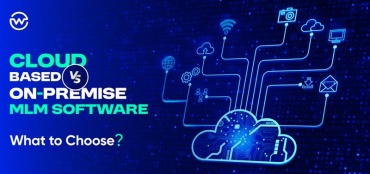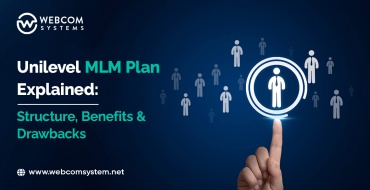Multi-level marketing (MLM) is one of the world’s most thriving multibillion-dollar industries. Businesses and distributors leveraging the MLM business model rely heavily on MLM software to streamline their operations and expand their networks. According to recent research, the MLM Software Market, which was USD 600 million in 2024, is expected to grow to approximately USD 1,259.12 million by 2031.
Nevertheless, as the industry continues to grow, MLM software has expanded beyond merely tracking sales. Modern software is now equipped with multiple features that allow it to securely, efficiently, and seamlessly support and scale MLM operations. These MLM software features are what distinguish MLM software as a reliable solution.
In this blog, we will explore the key features that an MLM software solution should have in 2025. Read to the end to discover each of them!
Understanding MLM Software
Before understanding the MLM software, let’s first know a little bit more about the “MLM.” It is a unique business model that constitutes a network of distributors that not only market the company’s products or services but also assist in expanding the distributor network. Although it may sound simple, as the network actually grows, it becomes extremely complex to track sales, distributors, recruits, and commissions. To simplify this MLM business model, MLM software solutions are employed worldwide.
Multilevel marketing software is essentially a platform that offers a centralized MLM system for more efficient management of the multi-tier marketing business operations. From tracking sales to managing the distributor recruitment network to commission tracking and payouts, this software covers it all. MLM software enhances the user experience for recruiters as well as distributors by streamlining operations, increasing transparency, improving efficiency, and enhancing network communication.
Must-Have Features Of MLM Software in 2025
Multi-level marketing software must have the following MLM features to be operational and truly beneficial for businesses:
Compensation Plan Management
As one of the primary goals of the MLM model is to connect more and more distributors, the compensation plan management feature can help with it. It supports the creation and management of multiple compensation models. Some of the most common MLM models are uni-level, generation, hybrid, matrix, and board. Further, these compensation models encourage distributors to increase sales and even reward them for exceptional performance.
Administration Back office
An admin back office built into the MLM software provides complete control for MLM businesses for efficient platform management. This back office manages various functionalities of the MLM system from one place. It allows the MLM administrators to set the payment options, change the user roles, modify packages, add or remove distributors, update business information, and much more.
Genealogy tree
Multi-level marketing consists of a complex organizational framework. A genealogy tree is provided in the MLM software solution to represent the network structure that both users and admins can view. There are various types of tree views available, including matrix, binary, multi-binary, and generation views, among others. This tree primarily represents the complete multi-level marketing (MLM) structure, including its distributors, their recruits, sales, commissions, and more.
Recommended Read: What is a Binary MLM Plan and How does it work?
Commission engine
An MLM business must provide timely and accurate payouts to its distributors to maintain authenticity and trust within its platform. However, as the MLM business network widens, it becomes difficult to calculate the commissions, enhancing the possibility of errors. That’s why MLM software is supplied with smart MLM calculators that manage the commission and bonus calculations of the distributors. An automated commission system can accurately compute commissions in real-time. Additionally, bonuses and commissions can be adjusted as needed to align with the current payout structures of the platform.
Secure and scalable architecture
MLM software platforms have a secure architecture to protect the MLM system from cyber threats, attacks, and unauthorized access. Even a minor breach can damage the company’s market reputation and hamper the trust among the network distributors and customers. Measures like SSL encryption, multi-factor authentication, regular updates, etc., can fortify the software to protect valuable data.
Along with this, the system infrastructure should have a scalable build to support business operations as the business and network participants grow.
Predictive Analytics
Predictive analytics features are included in software to give comprehensive information about distributor and sales performance. It aims to predict future sales patterns as well as identify and eliminate the risk on time. Not only that, but the feature allows MLM business administrators to recognize top performers and optimize their commissions accordingly.
Global Compliance And Tax Management
The MLM software must adhere to mandatory industry regulations and regional standards to ensure that MLM operations stay lawful and prevent any potential legal issues. Thus, the platform includes an automated taxation system that maintains compliance with GST, VAT, EU VAT, and other tax requirements. In addition to this, it adheres to standards such as GDPR, CCPA, PCI DSS, and more to maintain data security.
Third-Party API Integration
Third-party APIs, when integrated into software, enhance its functionality. That’s why the MLM software is provided with third-party API integration support to ensure seamless flow between different platforms. Multi-level marketing (MLM) businesses can incorporate diverse types of third-party solutions and services such as payment gateways, CRM systems, marketing tools, etc. The most popular integrations are to access e-commerce platforms, such as Shopify, WooCommerce, Magento, and others.
Powerful Add-Ons To Improve the Functionality of an MLM Software
Along with the above-mentioned features that are must-haves for any MLM software, some features can improve the MLM system even more. Here are some of these MLM features:
Mobile Accessibility
MLM software provides mobile accessibility along with web support so that platform users can monitor and manage operations from anywhere and at any time.
E-Wallet
A designated e-wallet integrated into the MLM software secures, simplifies, and speeds up financial transactions as well as improves fund management.
Lead Management System
Connecting different channels, the Lead Management System allows the MLM software solution to capture all the leads and create potent distributor pipelines.
Replicated System
A replicated system allows the MLM company to access branded websites without any additional effort. There is no need to design and develop the solution, as just minor tweaks can provide quick market entry.
Ticket System
A Ticket system can be extremely beneficial for the MLM business to instantly and efficiently address the concerns of the distributors.
Multi-Language Support
MLM software offers multilingual support so that the MLM enterprise can offer worldwide services and grow internationally.
Final Thoughts
Given its impressive functionality and vital role in operations, MLM software has evolved beyond being just a random tool and has become an essential technical solution. When equipped with the right features, it can refine the MLM business operational flow, improve service experience, and put the business on the path to massive success. If you are in search of feature-rich MLM software for your enterprise, Webcom Systems can help you. We specialize in building custom Multi-level marketing (MLM) solutions as per the specific needs of your business and industry. Get in touch to discuss your project.
Recommended Read: What Influence Can an MLM Software Have On Your Network Marketing Business?





